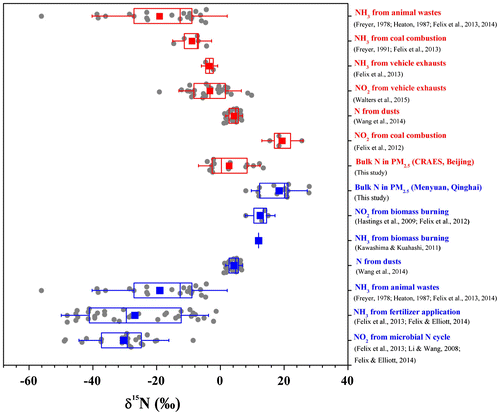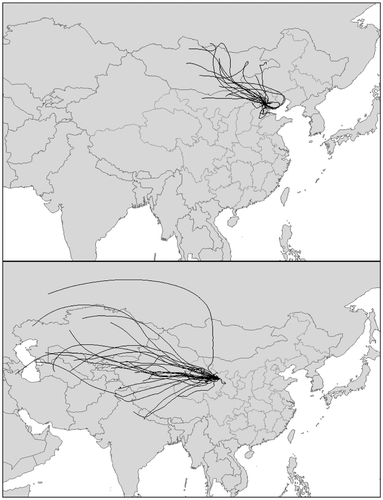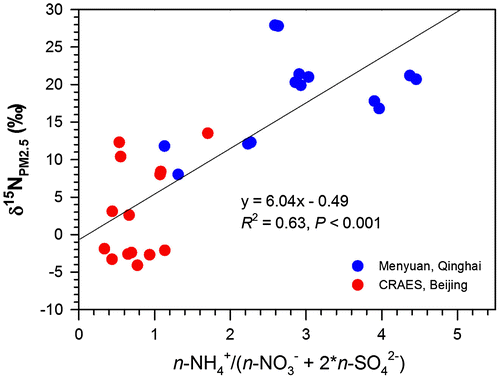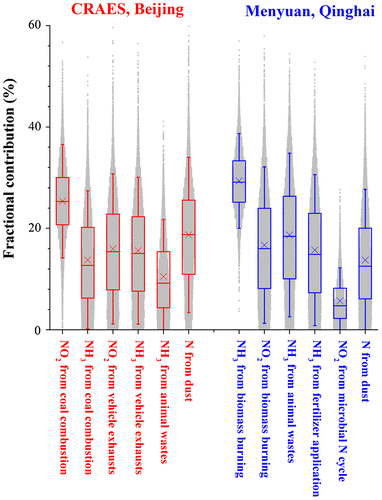Figures & data
Table 1. δ15N values (mean ± SD) reported for major NOx and NH3 emissions in the atmosphere.
Fig. 1. δ15N values of bulk N in PM2.5 and dominant N sources assigned for PM2.5 at the Beijing CRAES site (in red) and the Menyuan site (in blue). The box encompasses the 25th–75th percentiles, whiskers are SD values. The line and square in each box mark the median and arithmetic mean values, respectively. The number of jittered replicate δ15N data (dots around the boxes) is 1–34. Mean and SD values of source δ15N data were used in the SIAR model. δ15N values of N from dust were assumed as those of surface soils (Wang et al., Citation2014) according to the air mass backward trajectories (Fig. ).

Table 2. Mass concentrations of inorganic N ( –N plus
–N plus  –N),
–N),  –S, bulk N, molecular ratios of
–S, bulk N, molecular ratios of  to
to  ,
,  to
to  ,
,  to (
to ( ) in PM2.5 at Beijing (CRAES site) and a background site (Menyuan, Qinghai province) of China. Data of ambient NH3 and SO2 at Beijing site were cited from Carmichael et al. (Citation2003), He et al. (Citation2014), Wei et al. (Citation2015). Data of NH3 and SO2 were cited from the background site of Waliguan in Qinghai Province (Carmichael et al., Citation2003).
) in PM2.5 at Beijing (CRAES site) and a background site (Menyuan, Qinghai province) of China. Data of ambient NH3 and SO2 at Beijing site were cited from Carmichael et al. (Citation2003), He et al. (Citation2014), Wei et al. (Citation2015). Data of NH3 and SO2 were cited from the background site of Waliguan in Qinghai Province (Carmichael et al., Citation2003).
Fig. 2. Seventy-two-h air mass backward trajectories for all sampling dates at the Beijing CRAES site and the Menyuan site, based on NOAA HYSPLIT model back trajectories.

Fig. 3. Correlations between δ15N values of PM2.5 and molecular ratios of to (
) (expressed as n-
/n-(
)) in PM2.5 at Beijing CRAES site and Menyuan site. The regression line was drawn on data of both sites.

Table 3. Fractional contributions (F, %) of dominant N precursors and sources to bulk N in PM2.5 at Beijing (CRAES site) and a background site (Menyuan, Qinghai province) of China. Values (mean ± SD; n = 104) were calculated based on the output of the SIAR model.
Fig. 4. Fractional contributions of dominant N sources to bulk N in PM2.5 at the Beijing CRAES site and the Menyuan site. Dots around the boxes (n = 104) show the percentages estimated by the SIAR model. The box encompasses the 25th–75th percentiles, whiskers are the 5th and 95th percentiles. The line and cross in each box mark the median and arithmetic mean values, respectively.

